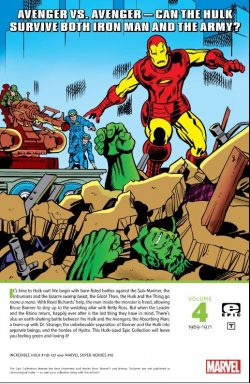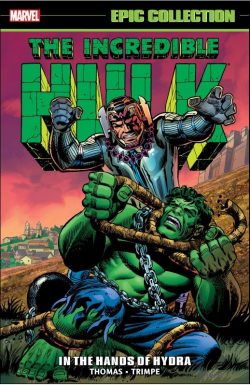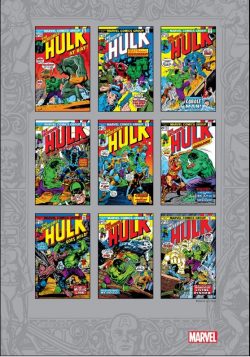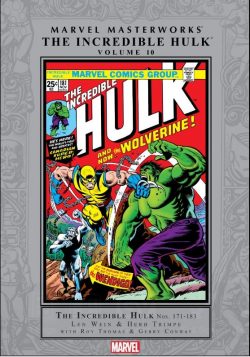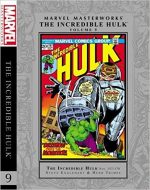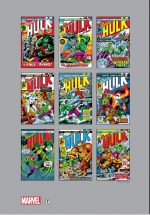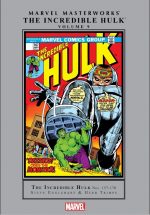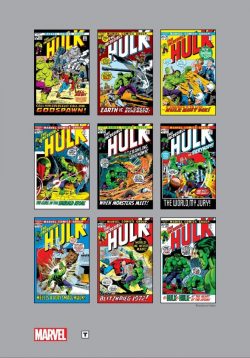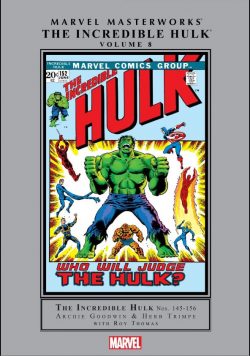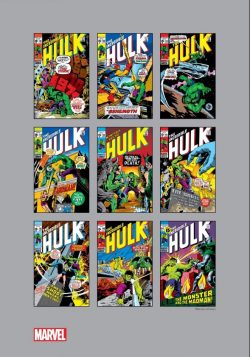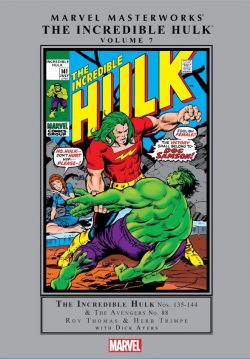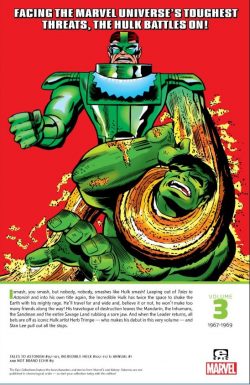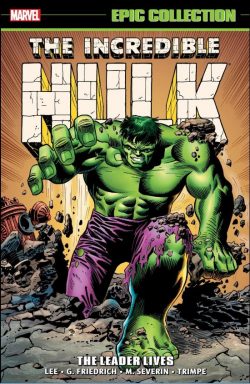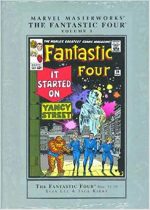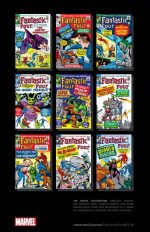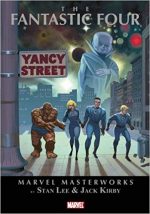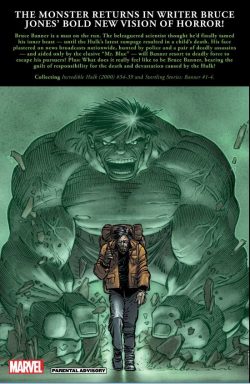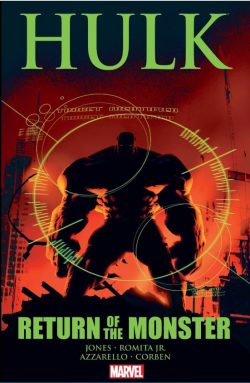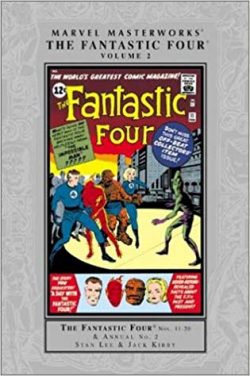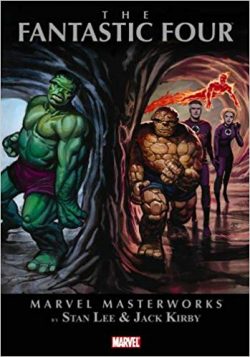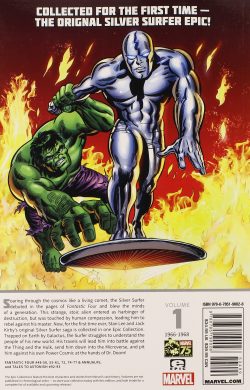
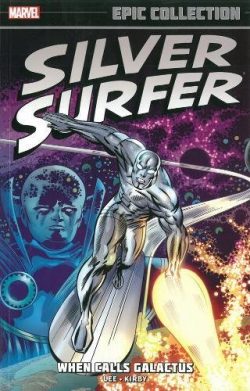
By Stan Lee, Jack Kirby, Marie Severin, Joe Sinnott, Frank Giacoia & various (Marvel)
ISBN: 978-0-7851-9002-8 (TPB)
Cautiously bi-monthly and cover-dated November 1961, Fantastic Four #1 (by Stan Lee, Jack Kirby, George Klein & Christopher Rule) was crude: rough, passionate and uncontrolled excitement. Thrill-hungry kids pounced on it and the raw storytelling caught a wave of change starting to build in America. It and succeeding issues changed comicbooks forever.
In eight short years FF became the indisputable central title and most consistently groundbreaking series of Marvel’s ever-unfolding web of cosmic creation: bombarding readers with a ceaseless salvo of new concepts and characters at a time when Kirby was in his conceptual prime and continually unleashing his vast imagination on plot after spectacular plot. Clearly inspired, Stan Lee scripted some of the most passionate superhero sagas that Marvel – or any publisher, for that matter – had or has ever seen.
Both were on an unstoppable roll, at the height of their creative powers, and full of the confidence that only success brings, with The King particularly eager to see how far the genre and the medium could be pushed. A forge of stunning creativity and endless excitement, the title was the proving ground for dozens of future stars and mesmerising concepts; none more timely or apt than the freewheeling cosmic wanderer and latter-day moral barometer dubbed The Silver Surfer.
Collecting every scrap of pertinent material from Fantastic Four #48-50, 55-61, 72, 74-77 FF Annual #5 and Tales to Astonish #92-93, this compendium reprints all appearances of the Starry-eyed Sentinel from March 1966 to August 1968 (admittedly some only in excerpt): a chronological countdown to the outcast winning his own landmark title.
Although pretty much a last-minute addition to Fantastic Four #48-50’s Galactus Trilogy, Jack Kirby’s scintillating creation quickly became a watchword for depth and subtext in the Marvel Universe and one Stan Lee kept as his own personal toy for many years to come.
The tale was a creative highlight from a period where the Lee/Kirby partnership was utterly on fire. The tale has all the power and grandeur of a true epic and has never been surpassed for drama, thrills and sheer entertainment, so you should really read it in all its glory.
Here, however, and without preamble the wonderment commences with a mere portion of ‘The Coming of Galactus!’ (by Lee, Kirby & Joe Sinnott from FF #48) as halfway through one storyline, the origins of the Inhumans saga is swiftly wrapped up by page 6, with the entire clandestine race sealed behind an impenetrable dome called the Negative Zone(later retitled the Negative Barrier to avoid confusion with the gateway to sub-space Reed Richards worked on for years).
Meanwhile, a cosmic entity approaches Earth, preceded by a gleaming herald on a surfboard of pure, shining cosmic energy…
I suspect this experimental – and vaguely uncomfortable – approach to narrative mechanics was calculated and deliberate, mirroring the way TV soap operas were increasingly delivering their interwoven storylines, and used as a means to keep readers glued to the series.
They needn’t have bothered. The stories and concepts were enough…
Issue #49 declares ‘If this be Doomsday!’ and sees planet-eating Galactus setting up shop over the Baxter Building despite the team’s best efforts, whilst his coldly gleaming herald has his humanity accidentally rekindled by simply conversing with the Thing‘s blind girlfriend Alicia Masters.
The first 13 pages of FF #50 concludes ‘The Startling Saga of the Silver Surfer!’ as the reawakened ethical core of the Surfer and gallantry of the human heroes buys enough time for Richards and the Human Torch to literally save the world with a boldly-borrowed Deus ex Machina gadget…
Once again, the tale ends in the middle of the issue, with the remaining half concentrating on the team getting back to “normalâ€, but that’s the work of a different review. Here we resume with FF #55 as ‘When Strikes the Silver Surfer!’sees the naive alien exiled on Earth by his former master and locked in uncomprehending, brutal battle with the Thing, whose insecurities over his relationship with Alicia explode into searing jealousy when the soaring skyrider comes innocently calling…
A portentous excerpt from #56 then tantalisingly teases another forthcoming epic. Fantastic Four #57-60 is Lee & Kirby at their very best; with unbearable tension, incredible drama and breathtaking action on a number of fronts as the most dangerous man on Earth steals the Silver Surfer’s Power Cosmic, even as the Inhumans finally win their freedom and we discover the tragic secret of mighty mute Black Bolt in all its awesome fury.
It all begins with a jailbreak by The Sandman in #57’s ‘Enter… Dr. Doom!’, escalates in ‘The Dismal Dregs of Defeat!’ as Doom tests his limitless stolen power in acts of random cruelty and destruction; builds to a crescendo in ‘Doomsday’ with the heroes’ utter defeat and abject humiliation, before culminating in brains and valour saving the day – and all humanity – in truly magnificent manner in ‘The Peril and the Power!’
A 2-page postscript from #61 shows the return to the Silver Surfer of his purloined life-energies, but there was never a dull moment: no sooner had the exile returned to his solitary wandering than he encountered another of Earth’s incredible denizens…
It coincided with a new narrative tone for The Hulk in his strip in split-book Tales to Astonish. After months on the run, fugitive Bruce Banner reached a ‘Turning Point!’ (TtA #92, June 1967, by Lee and superb, criminally underrated Marie Severin & Frank Giacoia), as the Jade Giant – hunted through a terrified New York City – has a close encounter with a gleaming light in the sky…
Back then, the Hulk didn’t really team-up with visiting stars, he just got mad and smashed them. Such was certainly the case when he became ‘He Who Strikes the Silver Surfer!’; ironically battling with and driving off a fellow outcast who held the power to cure him of his atomic affliction…
He was only driven as far as November’s Fantastic Four Annual #5, where – after a Kirby & Giacoia pin-up depicting a colossal group shot of Galactus, The Watcher, Silver Surfer and others – a rapidly rising star-in-the-making won his first solo appearance.
‘The Peerless Power of the Silver Surfer’ (Lee, Kirby & Giacoia) is a pithily potent fable of ambition and ingratitude reintroducing and upgrading the threat-level of the Mad Thinker‘s lethal Artificial Intelligence murder-machine Quasimodo…
Things went quiet until FF #72 (March 1968) and ‘Where Soars the Silver Surfer!’ as the sky-born wanderer, cruelly imprisoned on Earth by Galactus, goes cage-crazy and attacks humanity, forcing the quarrelsome quartet to make a violent and valiant intervention. Slightly calmer, the skyrider was back in #74 ‘When Calls Galactus’ as the world-eater returns to Terran skies, demanding his one-time herald once more become his food-finding slave. However, despite his increasingly violent and world-shaking probing and the FF’s holding action against the ravenous invader’s robotic Punisher, mighty Galactus cannot locate his target.
That’s because the Surfer has already – and utterly obliviously – departed for ‘World Within Worlds!’, forcing Reed, Ben and Johnny’s pursuit to save humanity from consumption. When the pioneering micronauts are subsequently attacked by sadistic alien Psycho Man, our heroes are subsequently ‘Stranded in Sub-Atomica!’
As they struggle to survive, Galactus applies ever-more pressure in ‘Shall Earth Endure?’ until the now-fully-apprised Surfer turns himself in to save Earth by finding the great Devourer an alternative snack. His reward is to be summarily returned to his captivity here as soon as ungrateful Galactus finishes feeding (just in time to begin his own landmark series – but that’s also the subject of another review, another time…)
Art lovers and history buffs can also enjoy a boundless bounty at the end of this volume as we close with fascinating freebies such as pages of original art by Kirby, a cover reproduction of earlier collection Silver Surfer: The Coming of Galactus! (Ron Lim, Dan Panosian & Paul Mounts), composite cover art for Wizard Ace Edition: Fantastic Four(2002) #48 by Mike Wieringo, Karl Kesel & Mounts, José Ladrönn’s cover for The Fantastic Four Omnibus volume 2and Dean White’s painted cover based on FF #49 for Marvel Masterworks: The Fantastic Four volume 5.
Also on show is a gallery of new covers crafted for 1970s reprint series Marvel’s Greatest Comics (#35-7 by John Buscema & Sinnott, Sal Buscema and Gil Kane & Giacoia) and Marvel Triple Action #1-4 (John B & Giacoia, Kane & John Romita, Vince Colletta and Sal B & Sinnott) which previously reprinted the material contained herein.
Epic, revolutionary and unutterably unmissable, these are the stories which made Marvel the unassailable leaders in fantasy entertainment and which remain some of the most important superhero comics ever crafted. The verve, conceptual scope and sheer enthusiasm shines through on every page and the wonder is there for you to share. If you’ve never thrilled to these spectacular sagas then this book of marvels is the perfect key to another – far brighter – world and time.
© 2019 MARVEL. All rights reserved.

